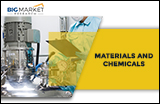
Global Aluminum Hydroxide Market
- MAR2978817
- 224 Pages
- July 2018
- Materials and Chemicals
End-user/Technology
The chemical industry dominated the end-user industry segment in 2017. Aluminum hydroxides are widely used as fire retardants in polymer applications. They are used mainly in fire fighting because of properties like durability, safety and insulation. In addition to this, aluminum hydroxide is used as a smoke suppressant in a wide range of polymers such as rubber, polyesters, acrylics and PVC. The pharmaceutical industry is also a major end user industry of aluminum hydroxide. It is found in drugs such as antacid, as it helps to reduce acidity, which in turn alleviates the symptoms of dyspepsia, heartburn and ulcers.
Market Dynamics
Aluminum hydroxide is widely used as a feedstock for the production of other aluminum compounds such as alumina, aluminum metal and aluminum chloride. This is a major driver for the growth of the global aluminum hydroxide market growth.
Market Segmentation
The global aluminum hydroxide market is segmented on the basis of different product types, applications and major geographical zones.
Regional/Geographic Analysis
Asia-Pacific has accounted for the largest market for aluminum hydroxide in 2017. It was closely followed by North America and Europe. The global aluminum hydroxide market is also widely based in China, Japan, South-East Asia and Middle East and Africa.
Opportunities
Due to the progressive technology used in North American countries such as the United States, Mexico and Canada, there is a great opportunity for a drastic increase in the Aluminum Hydroxide market share and Aluminum Hydroxide market revenue in the next five years of forecast period. This growth can be anticipated due to the strict regulations imposed by EPA in the United States, CEPA in Canada and WEEE & REACH in Europe. This is done specially for environment and consumers' safety, by regulating the policies pertaining to flame retardants.
Key Players
Some of the major vendors operating in the global aluminum hydroxide market are Huber, Nabaltec, Sumitomo, Almatis and Showa Denko.
Report Contents:
> Market segments
> Market Drivers, Restraints and Opportunities
> Market Size & Forecast 2016 to 2022
> Supply & Demand Value Chain
> Market - Current Trends
> Competition & Major Companies
> Technology and R&D Status
> Porters Five Force Analysis
> Strategic and Critical Success Factor Analysis of Key Players
Regional Analysis:
> North America
>> US and Canada
> Latin America
>> Mexico, Brazil, Argentina and Rest of Latin America
> Western Europe
>> EU5 (Germany, France, Italy, Spain, U.K.)
>> Nordic Countries (Denmark, Finland, Norway, and Sweden)
>> Benelux (Belgium, The Netherlands, and Luxembourg)
>> Rest of Western Europe
> Eastern Europe
>> Russia
>> Poland
>> Rest of Eastern Europe
> Asia Pacific
>> China
>> India
>> Japan
>> Australia and New Zealand
>> Rest of Asia Pacific
> Middle East and Africa
>> GCC countries (Saudi Arabia, Oman, Qatar, Bahrain, UAE and Kuwait)
>> South Africa
>> North Africa
>> Rest of Middle East and Africa
This report is an elaborate aggregation of primary inputs from industry experts and participants across the supply chain. It provides details on market segmentation which is derived from several product mapping exercises, macroeconomic parameters and other qualitative and quantitative insights. The impact of all such factors is delivered across multiple market segments and geographies.
Report Highlights:
> Detailed Historical Overview (Market Origins, Product Launch Timeline, etc.)
> Consumer and Pricing Analysis
> Market dynamics of the industry
> Market Segmentation
> Estimated Market Sizing in terms of volume and value
> Recent trends in Market and impact
> Research Status and Technology Overview
> Extensive Industry Structure Coverage
Similar Reports
Photonic Crystals are attractive optical materials for controlling and manipulating the flow of light. The global market for components and modules using Photonic Crystals indicates a CAGR of 33.1% and is estimated to reach $20.4 billion in 2017.
Nanomaterials possess nanoscale dimensions ranging from 1 to 100 nanometers. They occur naturally or can be engineered with specific properties such as size, shape, surface, and chemistry. Volcanic ash and forest fibers are some of the examples of natural nano...
- Publish Date: September 10, 2016
- $5820
Global molded plastics market was valued at $529,845 million in 2016, and is expected to garner $690,158 million by 2023, registering a CAGR of 3.9% from 2017 to 2023. Molded plastics are synthetically produced non-metallic compounds, which can be molded ...
- Publish Date: July 4, 2017
- $5370